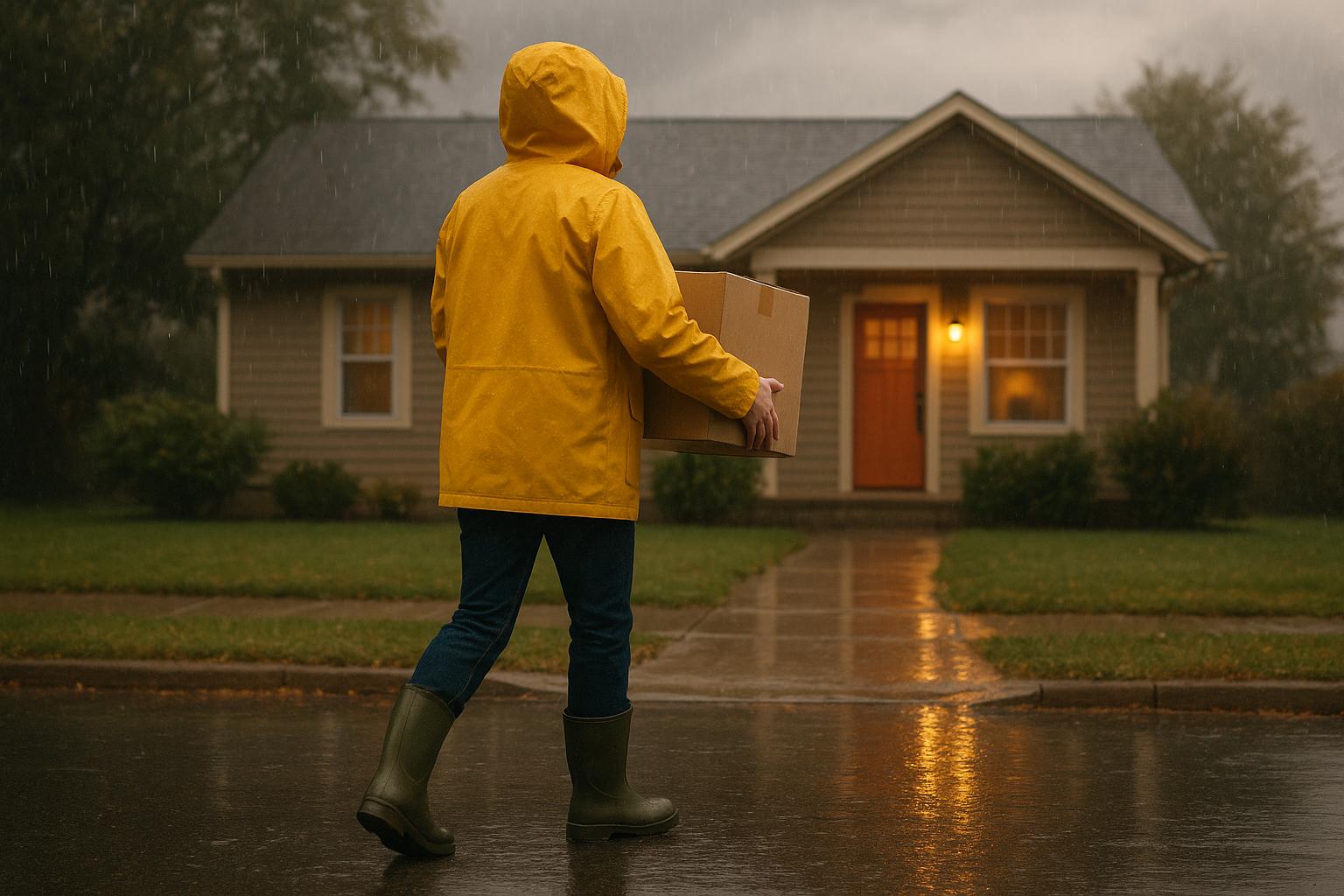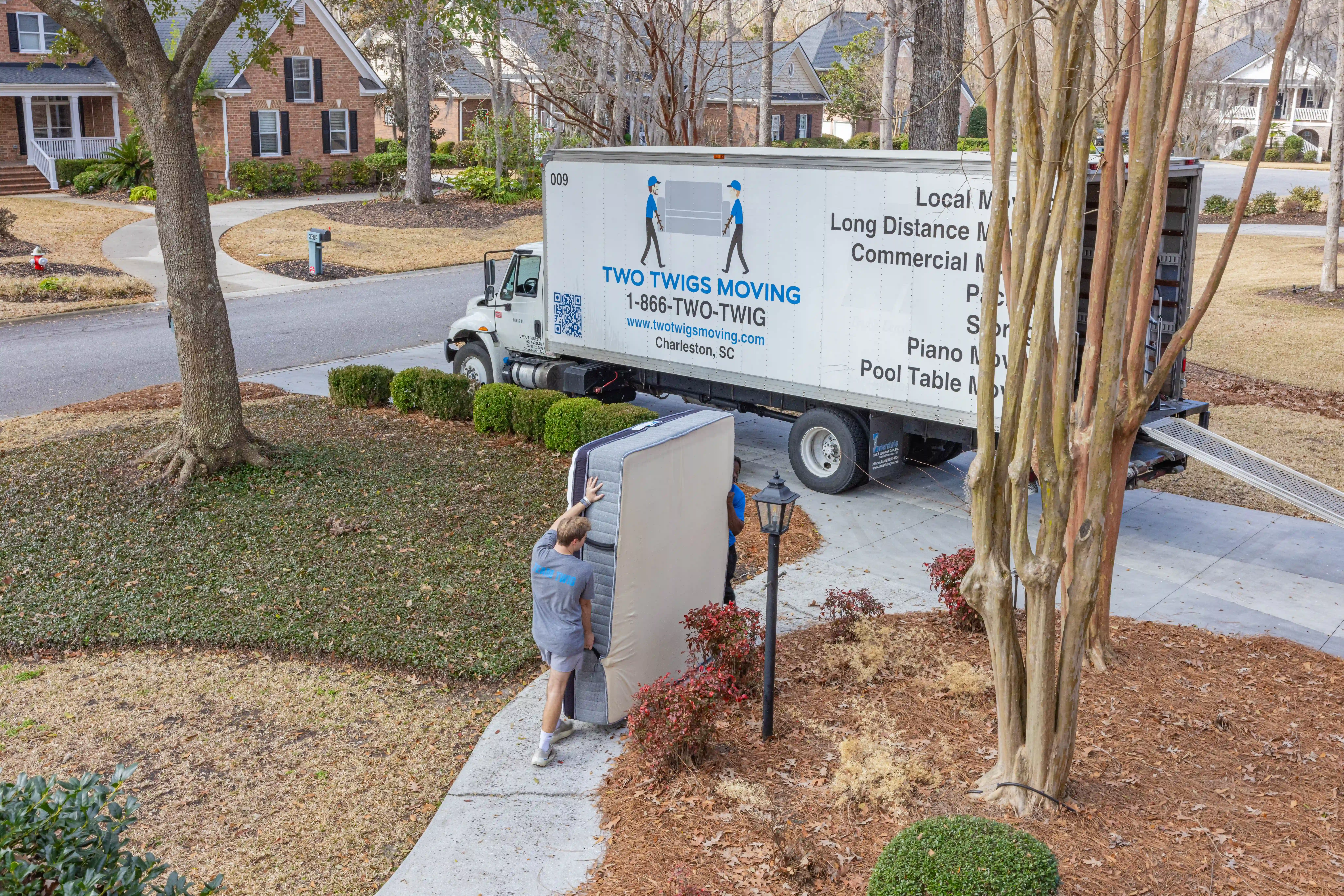Moving in stormy weather is challenging but manageable with the right preparation. The risks include safety hazards, transportation delays, and potential damage to your belongings. Here’s how you can stay safe and protect your items:
- Safety First: Clear walkways, keep indoor areas dry, and pause activities during severe conditions like high winds or lightning.
- Weather Monitoring: Check forecasts a week in advance and plan for flexible schedules. Have backup dates ready.
- Protect Belongings: Use waterproof materials like plastic wrap, bins, and tarps. Pack fragile items with extra care, and keep essentials in waterproof holders.
- Emergency Preparedness: Assemble a kit with flashlights, water, snacks, chargers, and first aid supplies.
- Professional Help: Experienced movers can handle storm-related challenges with proper tools and expertise.
Delays are better than risking safety. Prioritize planning, stay flexible, and use professionals if needed to ensure a safer, smoother move.
How to Check Weather and Time Your Move
Moving during stormy weather requires careful planning, regular weather checks, and the ability to adapt your schedule. Here’s how you can stay ahead of the weather and make your move as smooth as possible.
How to Track Weather Forecasts
Start monitoring the weather at least a week before your move. Keeping an eye on the forecast well in advance gives you time to spot potential storms and adjust your plans accordingly. Once you’ve established a habit of checking the weather, focus on identifying the safest time frames for your move.
Best Times of Day to Move
If bad weather is predicted, aim to schedule your move during a time when conditions are expected to be calmer. Even a short break in the weather can provide a safer window for moving. If the forecast worsens, it’s better to delay rather than risk unsafe conditions.
Once you’ve pinpointed a safer window, keep your plans flexible to accommodate any sudden changes.
Planning for Schedule Changes
Flexibility is crucial when stormy weather threatens to disrupt your move. Have backup dates ready and communicate any changes to your moving company as soon as possible. Keeping everyone in the loop ensures your plans can adjust smoothly if needed.
Additionally, stock up on extra tarps and plastic sheets to protect your belongings, and identify a dry indoor area for loading and unloading. Above all, remember that safety should always take priority over sticking to a rigid schedule.
Safety Steps During a Stormy Move
When moving during a storm, safety should always come first. Stormy weather can create hazardous conditions both outside and inside, so it’s crucial to have a plan that addresses these risks.
Clearing Walkways and Entry Points
Rain, snow, and mud can turn walkways and entry points into slippery, dangerous zones. Start by clearing away debris, standing water, and any obstacles from these areas. Proper drainage is key to preventing mud and water from collecting. Once the outdoor paths are safe, you can turn your attention to ensuring the indoors stays hazard-free.
Reducing Indoor Mess and Hazards
Stormy weather often means water, mud, and debris get tracked inside, creating slippery surfaces and potential damage to floors. Keep the indoors clean and dry by placing mats or towels near entry points and regularly mopping up any moisture. This simple step can make a big difference in preventing accidents and keeping the space safe for movers and helpers.
How to Pack and Protect Your Belongings
Keeping your belongings safe from storm damage means packing smart and using the right materials. Storms bring water, wind, and flying debris that can wreak havoc on your possessions if you’re not prepared. Once you’ve taken general safety measures, packing carefully becomes the next step to safeguard your valuables from unpredictable weather.
Using Waterproof Materials and Covers
Waterproofing is key when moving during stormy conditions. Start with plastic wrap – use it to tightly cover furniture, pairing it with heavy-duty waterproof pads secured with tape. Opt for plastic storage bins instead of cardboard boxes, as they offer better protection against water. If you must use cardboard, wrap the boxes in plastic bags and seal them with waterproof tape to keep moisture out.
For larger items, tarps and moving blankets work well as protective layers. Just make sure to secure them tightly to prevent wind from loosening or tearing them.
Packing Fragile and High-Value Items
Your delicate and high-value items need extra care. For electronics, use their original boxes if you have them, or wrap them in anti-static bubble wrap before placing them in waterproof containers. Artwork and mirrors should be wrapped with waterproof material, fitted with corner protectors, and stored in plastic boxes. Musical instruments are best packed in hard cases with moisture absorbers, and the cases themselves should be wrapped in plastic for added protection.
For smaller valuables like jewelry, use small waterproof containers and then place those in larger, padded waterproof boxes for double-layered security.
Organizing Important Items
Some items need to stay accessible and safe. Store documents, medications, and other essentials in waterproof holders. Create an emergency essentials box with items like chargers, flashlights, and basic tools, and keep it in your vehicle for easy access. To stay connected, put together a communication kit with backup chargers, a battery-powered radio, and emergency contact information written on waterproof paper.
sbb-itb-a5538b6
Using Professional Help for a Stress-Free Move
Once you’ve tackled safety and packing strategies, bringing in professional movers can make a stormy moving day far less overwhelming. When bad weather looms, experienced movers come prepared with the right skills and tools to handle challenging conditions. While you can take steps to prepare on your own, professionals know how to navigate the added risks that storms bring.
Expert Care for Fragile Belongings
Professional movers have the know-how and materials to protect delicate items even in tough weather. For example, they’ll shield pianos with waterproof covers and handle them with care, disassemble and wrap pool tables to keep them dry, and use extra padding and secure packing for items like artwork, electronics, and antiques. These measures help reduce the chances of damage, even when roads are slick or conditions are unpredictable. By combining their expertise with your own preparations, you can better safeguard your belongings during the move.
Flexible Service Options for Changing Plans
Professional moving companies also offer flexible services to reduce stress, especially when the weather throws a wrench in your plans. Take Two Twigs Moving, for instance – they provide customizable packages designed to address weather-related challenges. Their Full-Service Move includes professional packing to protect your items, while their Labor Only option gives you control over the process with expert support. And if storms cause unexpected delays, their Storage Solutions provide a secure, temporary place for your belongings until conditions improve.
Local Expertise in Charlotte, Charleston, and Greenville
Two Twigs Moving also brings valuable local knowledge to the table, which can be a game-changer in stormy weather. In Charlotte, they map out safe alternative routes during heavy rain. In Charleston, they’re equipped to handle sudden storms and high winds common to coastal areas. And in Greenville, they adapt to the region’s varied terrain and shifting conditions. Their familiarity with local building regulations and moving policies for apartments, offices, and other properties ensures a smooth and safe move, even when the weather doesn’t cooperate.
Emergency Planning and Backup Strategies
When dealing with a storm during a move, having a solid emergency plan can make all the difference. Even with meticulous preparation and professional assistance, storms can throw unexpected challenges your way. Roads might flood, power could go out, or severe weather might delay your timeline. A well-thought-out backup plan helps you stay calm and make smart decisions when things don’t go as planned.
Building an Emergency Kit
An emergency kit is a must-have for moving day, especially during storm season. Here’s what to include:
- Flashlights and extra batteries: Essential for power outages during loading or unloading.
- First aid supplies: Stock bandages, pain relievers, and any prescription medications you or your family might need.
- Non-perishable snacks and bottled water: Aim for at least one gallon of water per person in case of delays.
- Phone chargers and portable battery packs: Keeping devices charged is crucial for coordinating with movers or emergency services.
- Cash in small bills ($200–300): Useful for tips, emergency supplies, or alternative transportation if card systems are down.
Having these essentials on hand ensures you’re prepared for any hiccups along the way.
Backup Plans for Delays
Storms often bring delays, so it’s smart to build flexibility into your moving schedule. Here’s how to prepare:
- Start utilities a day early: Set up electricity, water, and heat to begin at least 24 hours before your move. This way, you’ll have access to basic services even if there’s a delay.
- Plan for temporary lodging: Book a pet-friendly hotel or have a list of friends or family who can host you for a night or two. Some hotels may offer discounts for those displaced by weather, so ask about special rates.
- Protect important documents: Scan key papers to your phone or cloud storage, and keep physical copies in a waterproof folder that stays with you during the move.
- Stay in touch with your movers: If weather forecasts predict problems, contact your moving company as early as possible. Many movers prefer rescheduling 24–48 hours in advance to avoid unsafe conditions.
These steps will help you adapt quickly if your plans are disrupted by bad weather.
What to Do When Weather Gets Worse
Storms can escalate without warning, and knowing how to respond is critical. If conditions deteriorate, here’s what to do:
- Pause all moving activities: Stop immediately if there’s lightning, thunder, or winds exceeding 25 mph. Continuing in these conditions can be dangerous.
- Secure loaded items: Double-check that everything in the moving truck is properly tied down and covered with waterproof tarps. Lock the truck to protect items from rain damage.
- Find shelter indoors: Move everyone to a safe location, away from windows and large trees. Avoid using elevators during thunderstorms in case of power outages. If you’re in a new home, identify the safest room – typically an interior space on the ground floor.
- Monitor weather updates: Use a battery-powered or hand-crank radio if the power goes out. While weather apps are helpful, conserve phone battery by checking updates every 30 minutes instead of constantly refreshing. Wait for official all-clear signals before resuming your move.
- Document damages: If weather causes damage to your belongings, take photos and detailed notes right away. This documentation will be critical for filing insurance claims. Capture wide shots of the scene as well as close-ups of specific damaged items.
Conclusion: How to Move Successfully in Stormy Weather
Moving during stormy weather doesn’t have to be overwhelming if you’re well-prepared. Start by planning ahead and having backup strategies in place to handle storm-related hurdles. This kind of preparation helps you stay safe while tackling unexpected challenges.
Your safety should always come first. If high winds or lightning strike, it’s wise to pause all moving activities until the weather improves. Take precautions by securing your belongings with waterproof covers and keeping essential items – like clothes, toiletries, and important documents – separate and protected. Don’t forget to have an emergency kit ready with flashlights, water, snacks, and phone chargers. These small steps can make those inevitable delays much easier to manage.
Even with the best planning, bad weather can throw surprises your way. This is where professional movers can truly save the day. Companies like Two Twigs Moving are equipped to handle these situations with the right tools and expertise. Their ability to adapt quickly ensures your items are handled securely, even in harsh conditions. Plus, their local knowledge allows for flexibility – whether you need help with packing, loading, or adjusting your schedule.
Stay calm and flexible as the situation evolves. A brief delay is always better than putting your safety – or your belongings – at risk.
FAQs
How can I protect my belongings from getting wet during a move in stormy weather?
To keep your belongings safe during a stormy move, make sure to wrap furniture and electronics in waterproof covers or plastic wrap to protect them from rain. For smaller items, use waterproof bins or heavy-duty trash bags, and seal all boxes tightly to prevent moisture from seeping in. Upholstered furniture should be covered with plastic or thick blankets to avoid water damage.
Also, confirm that the moving truck is fully covered or enclosed to keep everything dry. If you’re hiring professional movers like Two Twigs Moving, their team can assist in securely packing and transporting your items, even when the weather doesn’t cooperate.
What should I do if the weather forecast changes suddenly on moving day?
If the weather takes an unexpected turn on moving day, make sure to reach out to your moving company right away. Let them know about the updated forecast and work together to figure out any necessary changes, whether that’s adjusting the schedule or tweaking the plan. Good communication is key to ensuring everyone is aligned and ready to handle the situation.
Before the big day, take a moment to ask your movers about their policies for bad weather and any backup plans they have in place. Being prepared and staying flexible can go a long way in reducing stress and keeping things on track, even when the weather doesn’t cooperate.
What safety steps should I take if a storm intensifies during my move to keep everyone safe?
If the weather takes a turn for the worse during your move, your first priority should be safety. Head indoors immediately – ideally to a sturdy building or a vehicle with a roof. Stay away from windows, glass doors, and electrical devices that are plugged into outlets. If you’re unable to get inside, seek shelter in the lowest level of a building or in an interior room without windows. Use items like pillows or helmets to protect yourself from flying debris.
Keep everyone updated on the storm’s progress and avoid driving through flooded areas or going near downed power lines. Make sure to secure any loose items that could become dangerous in strong winds. These steps can help keep you and your loved ones safe during severe weather.


.svg)


